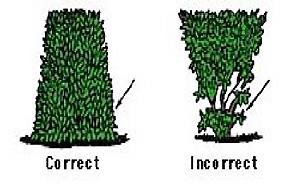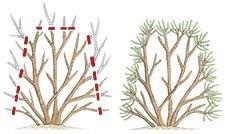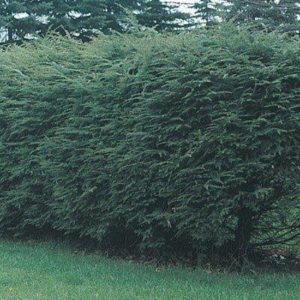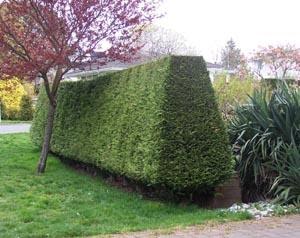Pruning Hedges
To have or to own a property with a hedges is to accept that maintenance is an ongoing issue. Hedges serve a great purpose, and add value to a property. Pruning hedges is a key aspect to maintaining that purpose and value. A hedge that has not been maintained can quickly become unsightly, and may take several season, or even several years to get it back to the desired goal. Depending on the size of the hedge, reestablishing an unruly hedge can be an expensive undertaking at the outset. However, cost usually go down as the project moves forward into the maintenance cycle.
Hedge Varieties
Broad leaf: English Laurel, Wax Leaf Privet, Rhododendrons, Portuguese Laurel
Conifers: Arborvitae, Leyland Cypress, English Yew, WR Cedar
Conifers -vs- Broad leaf Selecting the correct hedge variety will be vital in obtaining the desired outcome. Conifers may take more time to restructure due to the fact that you should not be cut back beyond the outer foliage. Large conifer hedges often will be left with a bit of a more “natural” look. Broad leaf can be cut further back in a restructure project than conifers, they also require maintenance more often.
Pruning Hedges - Height & Width Selection
A hedge should be maintained at its target height. When recovering or restructuring a hedge you may want to have it cut much lower and further back than the desired end result. Hedges that are over 8 ft tall are much more expensive to maintain. When doing restructuring a broad leaf hedge NW Tree Specialists strongly recommends a height of 5 ft tall. Then allow the hedge to re-grow to the desired height. This will help to keep cost down, at 5 feet there is no need for working from a ladder. The width is also a factor that will affect the cost of maintenance, a thin hedge is also easier to work on. Quite often NW Tree will do the beginning phase of restructuring and a landscape company may do the follow up for maintenance.


Pruning Hedges - Perfectly Sheared -VS- Natural Look
Shearing is the most common look for hedges that are in small or closely viewed areas, while a larger hedge may be trimmed with a more natural look (also known as inside to outside pruning). It is very important that there is a very clear understanding of the desired outcome. There is no correct answer to this question it is up to the property owner or agent.
Pruning Hedges - Project Details to Consider
Cutting back to Canes: When doing major reduction either horizontally or vertically, you WILL be left with exposed canes or sticks until new growth fills in.
Face – Top – Back: This refers to the 3 different parts of a hedge. FACE = The side that you see. TOP = the top of the hedge. Back = The side that your neighbor will see.
Fences: There are times when a hedge abuts a wood fence or wire fence, make sure that there is a clear plan of how this will be addressed.
Contour: When the hedge follows a hill or slope there needs to be an agreement on the changing elevations, should the hedge match the changing land contour, or hold a single line.
“HEDGES ARE A RICH MAN'S FENCE”
Any questions about scheduling or billing should go to the NW Tree Specialists office 503-645-2242
Questions about the logistics of a current or future job should go to your consulting arborist.



